

Astronomy 101
The Planets
Hi again!
This lab is meant to give you a good feel for the nature of
the Planets in our Solar System.
The Solar System is the system of planets and other objects
dominated by the gravity of our sun.
The
sun’s proper name is “Sol”.. hence the “Solar
System”.
Follow the directions below. Either type your
answers into
something like Microsoft Word, or type them directly into the text Box
in Canvas after clicking "Submit Assignment".
Part 1) The Size of the Planets
Go to this website: http://callumprentice.github.io/apps/celestial_bodies/index.html#
(NOTE: If
the site does not seem to work, try reloading, waiting longer for it to
load, or using a different web browser. If that does not
work,
you can accomplish the same thing at this site (although it's not as
visually fun:
http://sciencenetlinks.com/interactives/messenger/psc/PlanetSize.html
-- Select the two planets and click "compare")
When
the website loads it should look something like this:
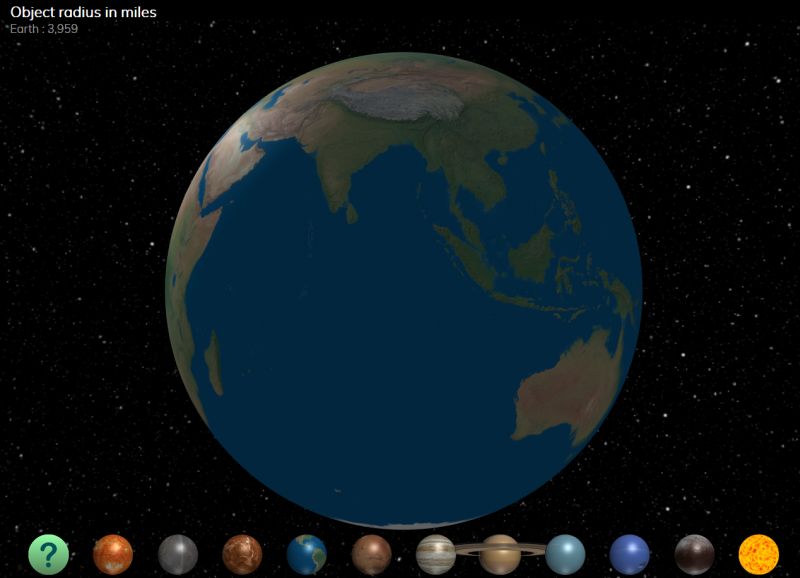
This
website exists to show the relative sizes of the Sun, the other
planets, some major moons, Pluto and another nearby star/planet system called "Trappist 1". Along the bottom, icons
of
the Sun, the eight planets in order from the Sun from left to right,
and Pluto and Trappiast 1.
- Move the mouse and
hover the cursor over each planet icon along the bottom. The
name
of the planet will appear. (Notice that some Planet's large
Moons
will also "grow" when you hover so that you can choose them also).
The Planets' icons are in the proper order from the Sun from
left
to right.
QUESTION 1) List the eight
planets in the correct order from the Sun.
Experiment by clicking on the Pluto
icon -- the one all the way to the right along the bottom. You will see Pluto's size correctly
displayed
next to the large earth like this:
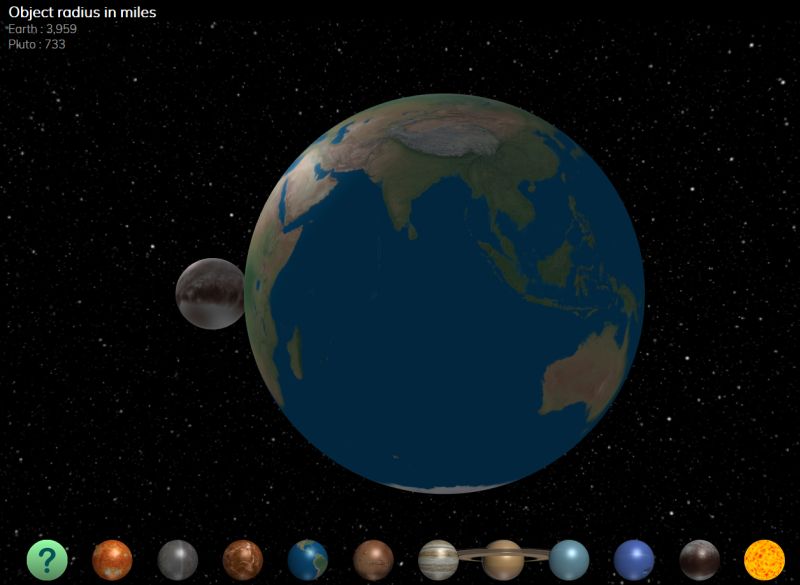
If you drag the mouse from left-to-right it will rotate the images like this:
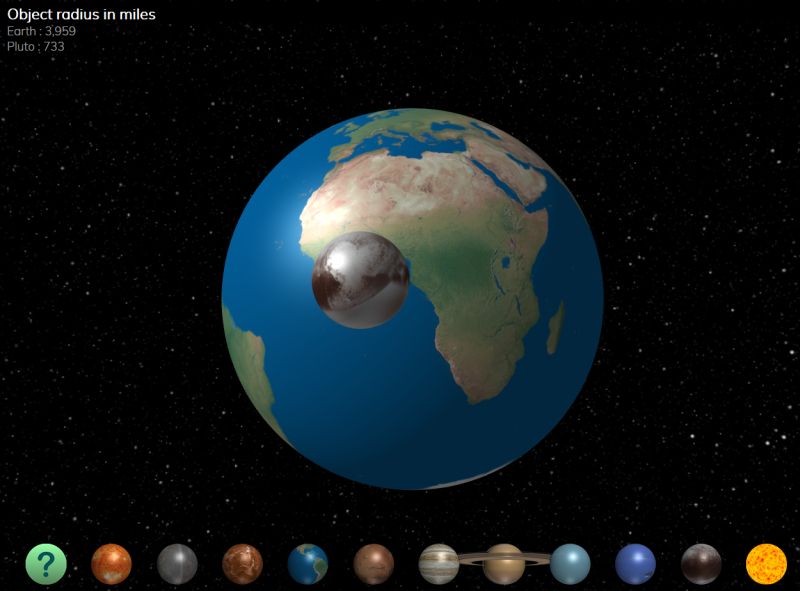
Also notice that the actual radii of both Pluto and the Earth are
displayed along the top.
By
clicking on the earth icons along the bottom, you can turn on and off
as many of the planets and moons as you wish. You can also hover
over the "?" and click on the "X" to reset the display.
- Use this website to compare the Earth to
the objects listed, and then for each object, describe A) its size
compared to earth, B) it's color, C) a description of any surface
features.
Example:
Pluto: A) Pluto is very small with a diameter only
about
1/5th the earth. B) it is brown and grey. C) It seems to have large
light and dark areas and I think I see some craters.
QUESTION 2) Do this same comparison between the Earth and the Sun
(NOTE: The Sun is so big compared to the earth that you might not even
be able to see the earth next to the Sun's image. Drag the mouse from left-to-right on
the Sun and you should see the earth superimposed in front of the Sun
and see it's relative size.)
QUESTION 3) Do this same comparison between the Earth and Venus
QUESTION 4) Do this same comparison between the Earth and
the Earth's Moon
QUESTION 5) Do this same comparison between the Earth and the Mars
QUESTION 6) Do this same comparison between the Earth and the Jupiter
- Spend some time playing by clicking on various objects to
determine their relative sizes.
QUESTION
7) List the eight planets and Pluto in correct order of size, from
smallest to largest. (You do NOT have to include the
Sun, or
any moons or Trappist 1.)
QUESTION
8) Three planets are smaller than the Earth. The
Earth and
these three smaller planets are the "terrestrial" or Rocky Planets.
List these three other terrestrial planets (Do NOT include Pluto which is no longer considered a planet by astronomers.)
QUESTION 9) Four of the Planets are quite a bit larger than the earth.
These are
the "jovian" or Gas Giant Planets. List these four planets.
Part 2) Your weight on Different planets
Your weight on the surface of a
planet depends on the pull of
gravity on the surface of that planet.
That force of Gravity depends on two things… 1) the mass
of the planet (the
GREATER the mass the GREATER the pull of gravity) and 2) the size
(radius) of
the planet (The GREATER the radius the LESS the pull of gravity).
Go to this website:
http://www.exploratorium.edu/ronh/weight/index.html
Scroll down and you should see this:
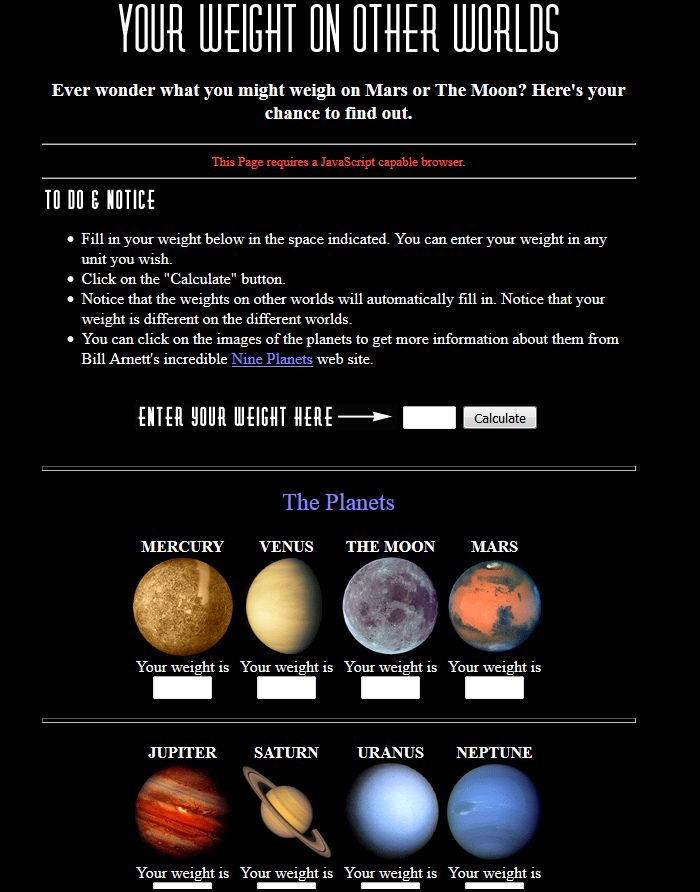
- Enter your weight in pounds and click "calculate" and see
what you would weigh on other planets.
QUESTION 10) Of the seven other Planets, the Moon, and Pluto, on which
object would your weight be the LEAST?
QUESTION 11) Of the seven other Planets, the Moon, and Pluto, on which
object would your weight be the MOST?
- Scroll
Down and you can see your weight calculated if you could stand on the
Sun (you'd need to be Superman!) and two other types of stars, a
"white dwarf" and a "neutron star".
QUESTION 12) What do you think would happen to you if you could be on
the surface of a neutron star? Explain.
Part 3) Planet Density
Density
can be thought of as "How heavy is something for its size?"
Something that is very heavy but has small size, is DENSE.
There
is an old riddle, "Which is heavier, a pound of feathers or a pound of
iron?" The answer, of course, is that they both weigh the
same...
one pound. You might be tempted to say iron, but iron is more
DENSE than feathers. A pound of iron is very small compared
to a
big one-pound pile of feathers.
The planets have a variety of densities. The most
dense planet is actually the Earth!

These
colored cubes are cubic centimeters. On average, a cubic
centimeter of the earth weighs 5.5 grams -- a little more than a
nickel. Water has a density of exactly 1.
Anything
with a density less than 1 would float in water.
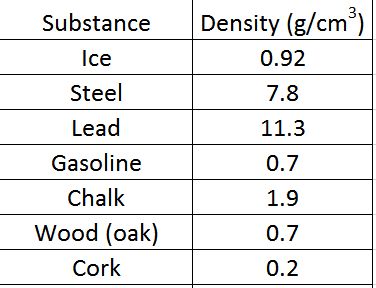
The Density of some common items
QUESTION 13) In the above table, what substances would float in water?
- Click HERE
to open a planet density calculator (NOTE: This uses javascript, which
must be enabled for your web browser. To check and to see how
to
enable javascript, go HERE.)
- From
the table below, enter the diameter and mass of the Planet Mercury in
the Planet Density Calculator. You should get an answer of
5.4
grams/cubic centimeter. (Mercury is almost as dense and the earth.)

- Only
one planet is actually less dense than water, and therefore would
float! Enter the relative Masses and Diameters of the various
planets from the table above into the Planet density calculator until
you find the one with a density less and 1 g/cc.
QUESTION 14) What is the one planet that would actually float?
QUESTION
15) The planet you found in answering question #14... A) Is it more or
less massive than the Earth? B) Explain in your own words
how something MORE massive
than the earth could be LESS dense.
Part 4) Synodic and Sidereal periods of the Planets
Watch the video introduction to the website "Solar System Scope" HERE
NOTE: The website has been
improved with more slick features since the above demo video was made,
but it still functions essentially the same.
Go to "Solar System Scope" by clicking HERE
NOTE:
The "Solar System Scope" app is also available with free versions for
both Android and IOS. In those versions you cannot drag the
planets around to move through time, but you can still do so using the
controls that become available after touching the date along the bottom.
NOTE 1: If the Solar system scope does not run properly at the above link, try another browser (Chrome or Firefox or...)
NOTE 2: If no browser works, try going to the Public Broadcasting Service site HERE
and click on "Launch Interactive" found part-way down the page.
If it runs, make the simulation full-screen by hitting the space
bar.
NOTE 3: If none of the above steps work on your computer, use an alternate site that works almost the same way found HERE.
Play with the website, and do the things you saw demonstrated in the
video.
As
a planet orbits the Sun, there are two important periods of time for
that planet, 1) The time it takes to orbit the sun ("Sidereal" period)
and 2) the time it takes to line back up with the Earth ("Synodic"
period). Most students don't automatically understand why the
"Synodic Period" is important, but remember, we are observing the
planets in our sky from the Earth which is also a moving planet.
The synodic period is how long it will be for a given planet
to
repeat its behavior (rise times, set times, visible in the morning or
the evening) as we see it from the Earth.
Watch this instructional video to show you how to find the synodic and
sidereal periods of the planets HERE
A website that calculates the duration between two dates can be found HERE
Use the method shown in the video to answer these questions NOTE: In questions 16-19 you MUST include the dates you used or you will receive NO CREDIT:
- Using the method shown in the video, find the sidereal
period of Mars (time to go around the Sun once)
QUESTION 16) What is the sidereal period of Mars, and what are the two
dates you used to find it?
- Using the method shown in the video, find the synodic
period of Mars (time to line back up with the Earth).
QUESTION 17) What is the synodic period of Mars, and what are the two
dates you used to find it?
- Using the method shown in the video, find the sidereal
period of Venus (time to go around the Sun once)
QUESTION 18) What is the sidereal period of Venus, and what are the two
dates you used to find it?
- Using
the method shown in the video (except you place Venus directly between
the earth and Sun) find the synodic period of Venus (time to line back
up with the Earth).
QUESTION 19) What is the synodic period of Venus, and what are the two
dates you used to find it?
- Play with the website. Scroll down and see a
couple of other cool similar websites like Day Light Map and Comet Ison.
QUESTION 20) What feature of Solar System Scope or the other sites did
you find most interesting?
That's it! Either upload your WORD document or copy your
answers into the canvas Submission box.









